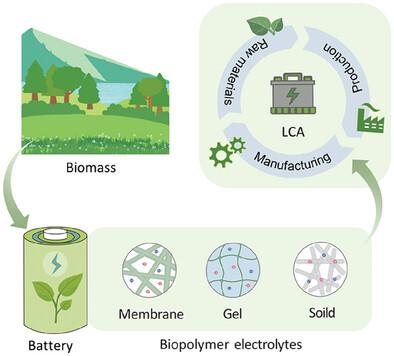Environmental Sustainability of Natural Biopolymer-Based Electrolytes for Lithium Ion Battery Applications
IF 27.4
1区 材料科学
Q1 CHEMISTRY, MULTIDISCIPLINARY
引用次数: 0
Abstract
Biopolymer based electrolytes can overcome current performance limitations of lithium-ion batteries (LIBs). Biopolymers enable electrolytes with high ionic conductivities and wide electrochemical stability windows. While the biobased character of natural materials is claimed as an inherent advantage in meeting current environmental sustainability challenges, further research is required to quantify and compare their environmental impacts as electrolytes. The challenge is addressed by identifying the most promising biopolymer electrolytes for LIBs, measuring ionic conductivities and electrochemical stability windows, and quantifying environmental impacts using life cycle assessment. The environmental impacts of the cost to isolate cellulose derivatives, nanocelluloses, chitin/nanochitin, chitosan, lignin, agar, and silk are reported for climate change, acidification, freshwater ecotoxicity, marine eutrophication, human toxicity, and water use. Material criticality, circularity index, and material circularity indicator, emerging impact categories are prioritized to help integrate biopolymers into circular and sustainable materials. The electrochemical properties and environmental impacts of natural biopolymer membrane-liquid electrolyte pairs, gel electrolytes, and solid electrolytes are quantified and benchmarked against conventional fossil-based electrolytes, providing consistent and comparable electrochemical properties of the most relevant biopolymer electrolytes fabricated so far. This study highlights the significant functional and environmental benefits of biopolymer electrolytes and identifies the most electrochemically competitive biopolymer electrolytes in LIBs.

用于锂离子电池的天然生物聚合物电解质的环境可持续性
基于生物聚合物的电解质可以克服目前锂离子电池(LIBs)的性能限制。生物聚合物使电解质具有高离子电导率和宽电化学稳定窗口。虽然天然材料的生物基特性被认为是应对当前环境可持续性挑战的固有优势,但需要进一步的研究来量化和比较它们作为电解质对环境的影响。通过确定最有前途的锂离子电池生物聚合物电解质,测量离子电导率和电化学稳定性窗口,以及使用生命周期评估量化环境影响,解决了这一挑战。报告了分离纤维素衍生物、纳米纤维素、几丁质/纳米几丁质、壳聚糖、木质素、琼脂和丝绸的成本对气候变化、酸化、淡水生态毒性、海洋富营养化、人体毒性和水利用的环境影响。材料临界性、循环度指数和材料循环度指标,新兴的影响类别被优先考虑,以帮助将生物聚合物整合到循环和可持续材料中。对天然生物聚合物膜-液体电解质对、凝胶电解质和固体电解质的电化学性能和环境影响进行了量化,并与传统的化石基电解质进行了基准测试,提供了迄今为止制造的最相关的生物聚合物电解质的一致和可比的电化学性能。本研究强调了生物聚合物电解质的重要功能和环境效益,并确定了lib中最具电化学竞争力的生物聚合物电解质。
本文章由计算机程序翻译,如有差异,请以英文原文为准。
求助全文
约1分钟内获得全文
求助全文
来源期刊

Advanced Materials
工程技术-材料科学:综合
CiteScore
43.00
自引率
4.10%
发文量
2182
审稿时长
2 months
期刊介绍:
Advanced Materials, one of the world's most prestigious journals and the foundation of the Advanced portfolio, is the home of choice for best-in-class materials science for more than 30 years. Following this fast-growing and interdisciplinary field, we are considering and publishing the most important discoveries on any and all materials from materials scientists, chemists, physicists, engineers as well as health and life scientists and bringing you the latest results and trends in modern materials-related research every week.
文献相关原料
公司名称
产品信息
阿拉丁
lithium chloride (LiCl)
阿拉丁
anhydrous acetonitrile (ACN)
阿拉丁
trimethylolpropane ethoxylate triacrylate
阿拉丁
2-Hydroxy-2-methyl-1-phenyl-1propanone
阿拉丁
Dopamine hydrochloride
阿拉丁
2-hydroxy-4′-(2-hydroxyethoxy)-2-methyl-propiophe (I2959)
阿拉丁
chloropropene
阿拉丁
urea
阿拉丁
sodium dihydrogen citrate (SDCA)
阿拉丁
lithium hydroxide (LiOH)
阿拉丁
sodium acetate anhydrous (CH3COONa)
阿拉丁
sodium chlorite (NaClO2)
阿拉丁
lithium bromide (LiBr)
阿拉丁
sodium hydroxide (NaOH)
阿拉丁
Carboxymethyl cellulose (CMC)
阿拉丁
propylene carbonate (PC)
阿拉丁
Glucose
阿拉丁
tetramethyl orthosilicate (TMOS)
阿拉丁
sodium ligninsulfonate
阿拉丁
carboxymethyl chitosan (CMCS) cellulose powder
阿拉丁
polyacrylonitrile (PAN)
阿拉丁
methyl cellulose (MC)
阿拉丁
poly(vinylidene fluoride-co-hexafluoropropylene) (PVDF-HPF)
阿拉丁
Hydroxyethyl cellulose (HEC)
 求助内容:
求助内容: 应助结果提醒方式:
应助结果提醒方式:


